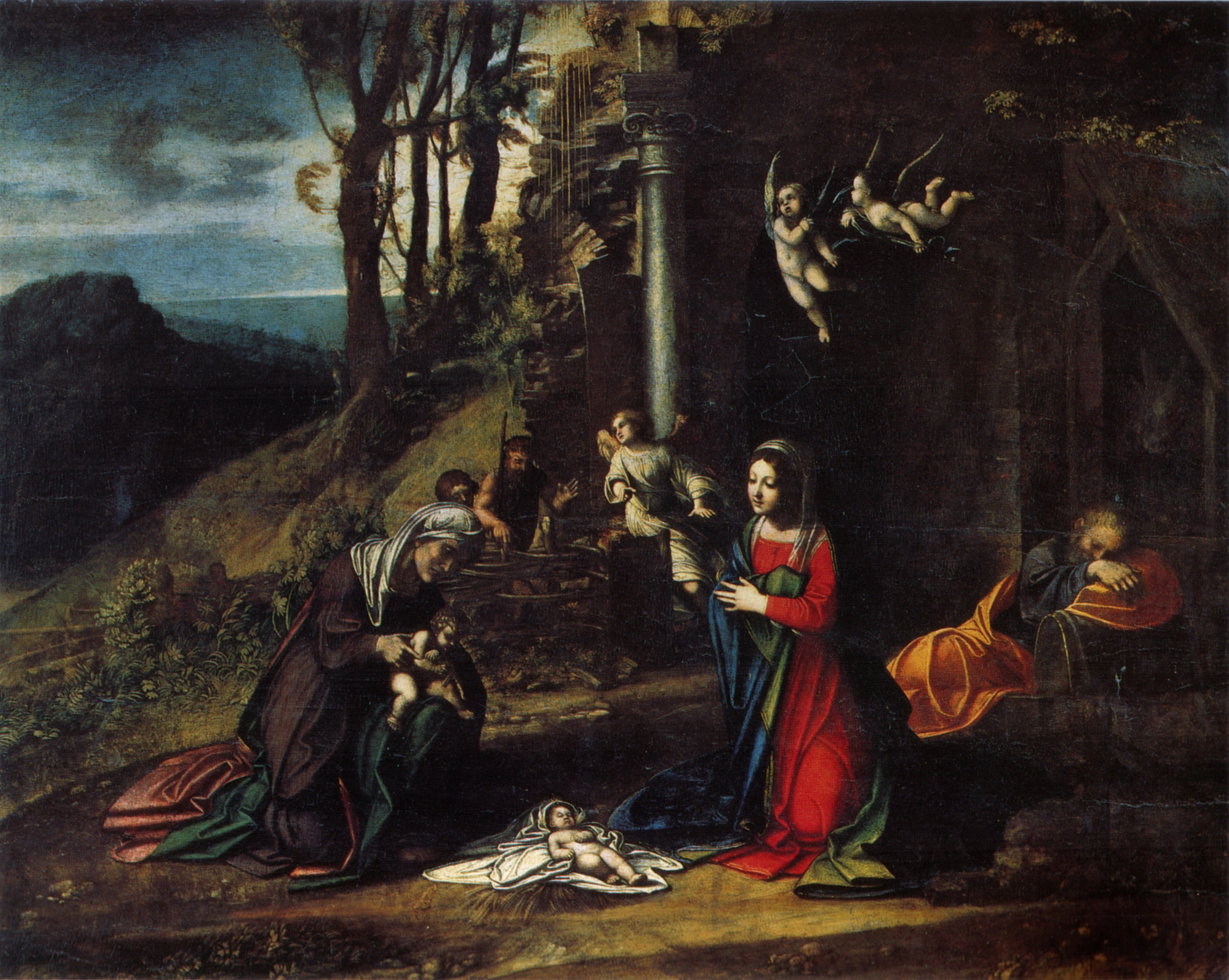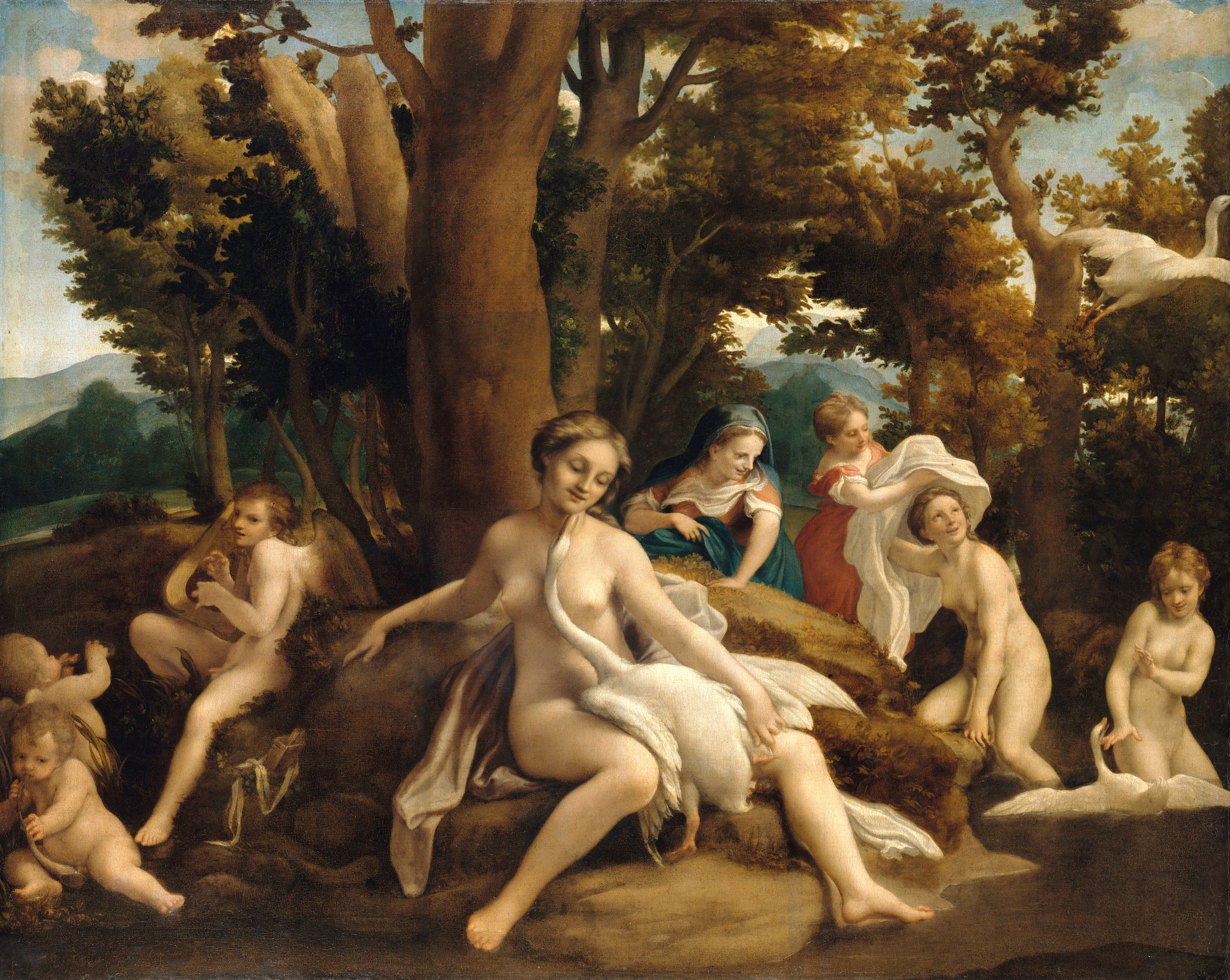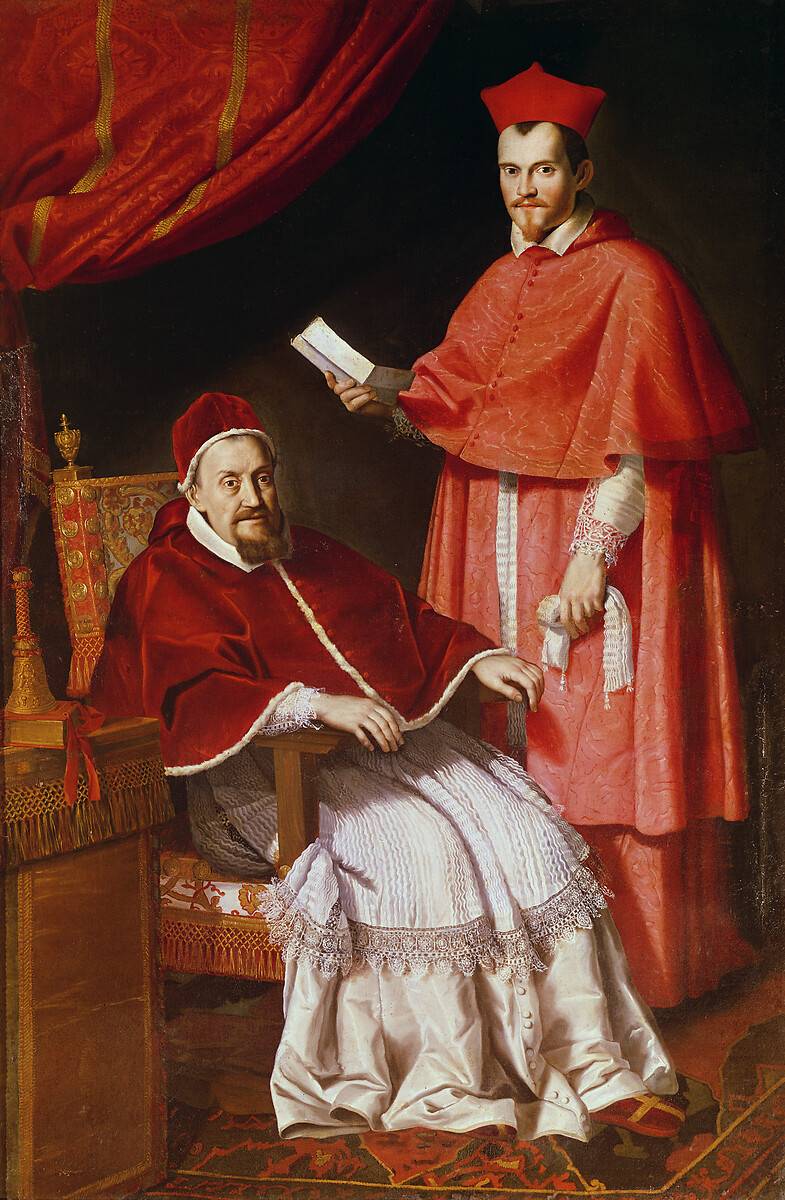|
Nativity With St Elizabeth And The Infant John The Baptist
''Nativity with St Elizabeth and the Infant John the Baptist'' is a c.1512-1513 oil on panel painting by Correggio, now in the Pinacoteca di Brera in Milan, which acquired it at an auction in Paris in 1913. It was painted during the artist's stay in Mantua, with heavy influence from Mantegna's ''Adoration of the Magi''. However, its commissioner and original location are both unknown, though the latter was probably a home rather than a church. In the 17th century it was recorded as being in the collection of cardinal Ludovico Ludovisi in Rome, before going on the art market and ending up in the collection of Benigno Crespi Cristoforo Benigno Crespi (18 October 1833 in Busto Arsizio – 5 January 1920 in Milan) was an Italian entrepreneur. Biography In 1897 a cotton textile industry was created in the province of Milan and the factory and its worker village, called .... References {{Antonio da Correggio category:1513 paintings category:Religious paintings by Correggio ... [...More Info...] [...Related Items...] OR: [Wikipedia] [Google] [Baidu] |
Correggio 007
Antonio Allegri da Correggio (August 1489 – 5 March 1534), usually known as just Correggio (, also , , ), was the foremost painter of the Parma school of the High Italian Renaissance, who was responsible for some of the most vigorous and sensuous works of the sixteenth century. In his use of dynamic composition, illusionistic perspective and dramatic foreshortening, Correggio prefigured the Baroque art of the seventeenth century and the Rococo art of the eighteenth century. He is considered a master of chiaroscuro. Early life Antonio Allegri was born in Correggio, a small town near Reggio Emilia. His date of birth is uncertain (around 1489). His father was a merchant. Otherwise little is known about Correggio's early life or training. It is, however, often assumed that he had his first artistic education from his father's brother, the painter Lorenzo Allegri. In 1503–1505, he was apprenticed to Francesco Bianchi Ferrara in Modena, where he probably became familiar with the ... [...More Info...] [...Related Items...] OR: [Wikipedia] [Google] [Baidu] |
Correggio
Antonio Allegri da Correggio (August 1489 – 5 March 1534), usually known as just Correggio (, also , , ), was the foremost painter of the Parma school of the High Italian Renaissance, who was responsible for some of the most vigorous and sensuous works of the sixteenth century. In his use of dynamic composition, illusionistic perspective and dramatic foreshortening, Correggio prefigured the Baroque art of the seventeenth century and the Rococo art of the eighteenth century. He is considered a master of chiaroscuro. Early life Antonio Allegri was born in Correggio, Italy, Correggio, a small town near Reggio Emilia. His date of birth is uncertain (around 1489). His father was a merchant. Otherwise little is known about Correggio's early life or training. It is, however, often assumed that he had his first artistic education from his father's brother, the painter Lorenzo Allegri (painter), Lorenzo Allegri. In 1503–1505, he was apprenticed to Francesco Bianchi Ferrara in Modena ... [...More Info...] [...Related Items...] OR: [Wikipedia] [Google] [Baidu] |
Pinacoteca Di Brera
The Pinacoteca di Brera ("Brera Art Gallery") is the main public gallery for paintings in Milan, Italy. It contains one of the foremost collections of Italian paintings from the 13th to the 20th century, an outgrowth of the cultural program of the Brera Academy, which shares the site in the Palazzo Brera. History The Palazzo Brera owes its name to the Germanic ''braida'', indicating a grassy opening in the city structure: compare the ''Bra'' of Verona. The convent on the site passed to the Jesuits (1572), then underwent a radical rebuilding by Francesco Maria Richini (1627–28). When the Jesuits were disbanded in 1773, the palazzo remained the seat of the astronomical Observatory and the Braidense National Library founded by the Jesuits. In 1774 the herbarium of the new botanical garden was added. The buildings were extended to designs by Giuseppe Piermarini, who was appointed professor in the Academy when it was formally founded in 1776, with Giuseppe Parini as dean. Pier ... [...More Info...] [...Related Items...] OR: [Wikipedia] [Google] [Baidu] |
Mantua
Mantua ( ; it, Mantova ; Lombard language, Lombard and la, Mantua) is a city and ''comune'' in Lombardy, Italy, and capital of the Province of Mantua, province of the same name. In 2016, Mantua was designated as the Italian Capital of Culture. In 2017, it was named as the European Capital of Gastronomy, included in the Eastern Lombardy District (together with the cities of Bergamo, Brescia, and Cremona). In 2008, Mantua's ''centro storico'' (old town) and Sabbioneta were declared by UNESCO to be a World Heritage Site. Mantua's historic power and influence under the Gonzaga family has made it one of the main artistic, culture, cultural, and especially musical hubs of Northern Italy and the country as a whole. Having one of the most splendid courts of Europe of the fifteenth, sixteenth, and early seventeenth centuries. Mantua is noted for its significant role in the history of opera; the city is also known for its architectural treasures and artifacts, elegant palaces, and the m ... [...More Info...] [...Related Items...] OR: [Wikipedia] [Google] [Baidu] |
Andrea Mantegna
Andrea Mantegna (, , ; September 13, 1506) was an Italian painter, a student of Roman archeology, and son-in-law of Jacopo Bellini. Like other artists of the time, Mantegna experimented with perspective, e.g. by lowering the horizon in order to create a sense of greater monumentality. His flinty, metallic landscapes and somewhat stony figures give evidence of a fundamentally sculptural approach to painting. He also led a workshop that was the leading producer of prints in Venice before 1500. Biography Youth and education Mantegna was born in Isola di Carturo, Venetian Republic close to Padua (now Italy), second son of a carpenter, Biagio. At the age of 11, he became the apprentice of Paduan painter Francesco Squarcione. Squarcione, whose original profession was tailoring, appears to have had a remarkable enthusiasm for ancient art, and a faculty for acting. Like his famous compatriot Petrarca, Squarcione was an ancient Rome enthusiast: he traveled in Italy, and perhaps a ... [...More Info...] [...Related Items...] OR: [Wikipedia] [Google] [Baidu] |
Adoration Of The Magi (Mantegna)
The ''Adoration of the Magi'' or ''Uffizi Triptych'' is a group of three tempera-on-panel paintings by Andrea Mantegna, dating to around 1460. Their three subjects are the ''Ascension of Christ'' (86 by 42.5 cm), ''Adoration of the Magi'' the largest and central panel (76 by 76.5 cm) and the ''Circumcision of Christ'' (86 by 42.5 cm). They were gathered as a trio in the 19th century, although some art historians doubt that they were created as a triptych set in the way they are now arranged. They are now in the Uffizi Gallery in Florence. History Most scholars agree the three works were commissioned in the 1460s for Ludovico III Gonzaga's private chapel in the Castello di San Giorgio, Castle of St. George in Mantua (together with the Death of the Virgin (Mantegna), ''Death of the Virgin'', now in the Museo del Prado, and ''Christ Bearing the Soul of the Virgin'', now in Ferrara). The paintings for the chapel are mentioned in two letters from Mantegna to Ludovico da ... [...More Info...] [...Related Items...] OR: [Wikipedia] [Google] [Baidu] |
Ludovico Ludovisi
Ludovico Ludovisi (22 or 27 October 1595 – 18 November 1632) was an Italian Cardinal (Catholic Church), cardinal and statesman of the Roman Catholic Church. He was an art connoisseur who formed a famous collection of antiquities, housed at the Villa Ludovisi in Rome. Biography Ludovico Ludovisi was born in Bologna, then part of the Papal States, the son of Orazio Ludovisi and Lavinia Albergati. Following in the footsteps of his uncle Alessandro Ludovisi, he was trained at the Jesuit Collegio Germanico of Rome, and went on to the University of Bologna, where he received his doctorate in canon law on 25 February 1615. When Alessandro Ludovisi was acclaimed pope, taking the name Pope Gregory XV, Gregory XV, Ludovico was made cardinal the day after his coronation, though he was only 25. The following month he was made archbishop of Bologna though he remained in Rome. His uncle had great faith in his judgement and energy and was in need of a strong and able assistant to help gov ... [...More Info...] [...Related Items...] OR: [Wikipedia] [Google] [Baidu] |
Benigno Crespi
Cristoforo Benigno Crespi (18 October 1833 in Busto Arsizio – 5 January 1920 in Milan) was an Italian entrepreneur. Biography In 1897 a cotton textile industry was created in the province of Milan and the factory and its worker village, called Crespi d'Adda was built on the left bank of the river Adda between the towns of Capriate San Gervasio and Canonica d’Adda where the flow of water provided hydroelectric energy to power the cotton looms. It was in full production until the economic crash of 1929 when the family went bankrupt but was still producing in limited output up until its closure in 2004. Descendants of the original workers still live in the village. It has been a UNESCO World Heritage Site since 1995. His son, Silvio Benigno Crespi Silvio Benigno Crespi (24 September 1868 in Milan – 15 January 1944 in Cadorago) was an Italian entrepreneur, inventor and politician. Firstborn of Cristoforo Benigno Crespi and Pia Travelli. He succeeded his father in running th ... [...More Info...] [...Related Items...] OR: [Wikipedia] [Google] [Baidu] |
1513 Paintings
Year 1513 ( MDXIII) was a common year starting on Saturday (link will display the full calendar) of the Julian calendar. Events January–June * March 9 – Pope Leo X (layman Giovanni di Lorenzo de' Medici) succeeds Pope Julius II, as the 217th pope, despite a strong challenge by Hungarian cardinal Tamás Bakócz. * March 27 – Juan Ponce de León becomes the first European definitely known to sight Florida, mistaking it for another island. * April 2 – Juan Ponce de León and his expedition become the first Europeans known to visit Florida, landing somewhere on the east coast. * April 2 – Juan Garrido (as part of Juan Ponce de León's expedition) becomes the first African known to visit North America, landing somewhere on the east coast of Florida. * May – Portuguese explorer Jorge Álvares lands on Lintin Island, in the Pearl River estuary. * June 6 – Italian Wars – Battle of Novara: Swiss mercenaries defeat the French under L ... [...More Info...] [...Related Items...] OR: [Wikipedia] [Google] [Baidu] |
Religious Paintings By Correggio
Religion is usually defined as a social-cultural system of designated behaviors and practices, morals, beliefs, worldviews, texts, sanctified places, prophecies, ethics, or organizations, that generally relates humanity to supernatural, transcendental, and spiritual elements; however, there is no scholarly consensus over what precisely constitutes a religion. Different religions may or may not contain various elements ranging from the divine, sacred things, faith,Tillich, P. (1957) ''Dynamics of faith''. Harper Perennial; (p. 1). a supernatural being or supernatural beings or "some sort of ultimacy and transcendence that will provide norms and power for the rest of life". Religious practices may include rituals, sermons, commemoration or veneration (of deities or saints), sacrifices, festivals, feasts, trances, initiations, funerary services, matrimonial services, meditation, prayer, music, art, dance, public service, or other aspects of human culture. Religions ha ... [...More Info...] [...Related Items...] OR: [Wikipedia] [Google] [Baidu] |
Paintings In The Pinacoteca Di Brera
Painting is the practice of applying paint, pigment, color or other medium to a solid surface (called the "matrix" or "support"). The medium is commonly applied to the base with a brush, but other implements, such as knives, sponges, and airbrushes, can be used. In art, the term ''painting ''describes both the act and the result of the action (the final work is called "a painting"). The support for paintings includes such surfaces as walls, paper, canvas, wood, glass, lacquer, pottery, leaf, copper and concrete, and the painting may incorporate multiple other materials, including sand, clay, paper, plaster, gold leaf, and even whole objects. Painting is an important form in the visual arts, bringing in elements such as drawing, Composition (visual arts), composition, gesture (as in gestural painting), narrative, narration (as in narrative art), and abstraction (as in abstract art). Paintings can be naturalistic and representational (as in still life and landscape art, lands ... [...More Info...] [...Related Items...] OR: [Wikipedia] [Google] [Baidu] |
Nativity Of Jesus In Art
The Nativity of Jesus has been a major subject of Christian art since the 4th century. The artistic depictions of the ''Nativity'' or birth of Jesus, celebrated at Christmas, are based on the narratives in the Bible, in the Gospels of Matthew and Luke, and further elaborated by written, oral and artistic tradition. Christian art includes a great many representations of the Virgin Mary and the Christ Child. Such works are generally referred to as the "Madonna and Child" or "Virgin and Child". They are not usually representations of the ''Nativity'' specifically, but are often devotional objects representing a particular aspect or attribute of the Virgin Mary, or Jesus. ''Nativity'' pictures, on the other hand, are specifically illustrative, and include many narrative details; they are a normal component of the sequences illustrating both the Life of Christ and the Life of the Virgin. The Nativity has been depicted in many different media, both pictorial and sculptural. Pictoria ... [...More Info...] [...Related Items...] OR: [Wikipedia] [Google] [Baidu] |












.jpg)